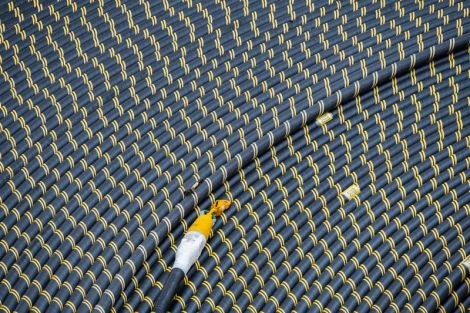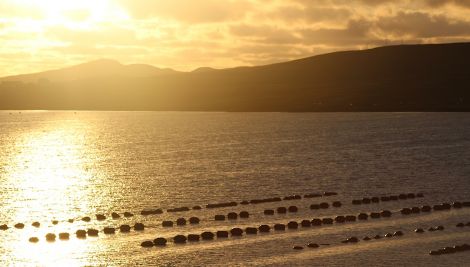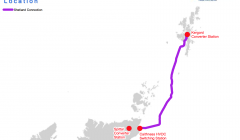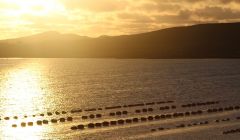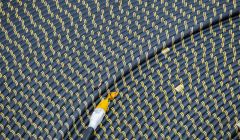Energy / Cable developer responds to concerns from mussel farmers
THE DEVELOPER behind plans for a subsea transmission link which would run from the northern tip of the Scottish mainland into Weisdale Voe in Shetland said it “recognises the importance” of the local shellfish industry following concern raised by mussel farmers operating in the voe.
SHE Transmission said it will “work to avoid inhibition” of mussel farming activity in the area.
It comes after a number of mussel farmers operating in and around Weisdale Voe, as well as industry body Seafood Shetland, expressed concern over the potential impact the cable and its installation would have on their operations.
Since then Scottish Sea Farms has also raised concern over the plans due to the proximity of two of its salmon farm sites in the approach to Weisdale Voe.
As it stands the proposed 250km long cable – which would connect Shetland to the national grid and allow large wind farms to export energy – would run from Noss Head in Caithness to Weisdale, with a 200m corridor in the voe as a works area.
From there the cable would be placed underground before heading north to a planned converter station at Upper Kergord.
However, there are six active mussel farms in Weisdale Voe and their operators recently responded to a works licence application submitted to Shetland Islands Council to express concern over the plans.
Among the worries were the distance from cable activity to farm sites and the potential impact of sediment on mussels.
Applicant SHE Transmission, which forms part of SSE, has now responded to the concerns.
It says it “remains committed to establishing proximity agreements” where necessary with operators in Weisdale Voe.
“It is intended that these agreements will allow mutual coexistence going forward and facilitate a framework for continued communication and collaboration between SHE Transmission and Seafood Shetland’s members,” the company said.
Become a member of Shetland News
It also claimed that the distance from the cable to mussel farm sites would be greater than previously expressed as the link’s route is intended to be located in the middle of the installation corridor. SHE Transmission said that distances quoted by the seafood industry were to the boundary of the 200m corridor.
The transmission company also said it “does not expect any adverse effects on the farmed mussels” from sediment due to the distance involved.
It added that it is committed to maintaining access to the aquaculture sites during the cable installation works, with guard vessels set to be used to ensure safe passage.
SHE Transmission also said it wants to ensure “ongoing consultation with our stakeholders is maintained through alternative means”, such as video conferencing, during the coronavirus pandemic.
It said it is keen to host meetings with Seafood Shetland members.
SHE Transmission has also responded to some concerns raised from members of the public, although many of the topics were deemed to be out of scope to the application.
In terms of the impact of the development of renewable generation on Shetland, it said: “Scottish Hydro Electric (SHE) Transmission is required by its licence to provide connection to the UK’s transmission network when requested by a generator, SHE Transmission has a statutory duty to develop, maintain and operate an efficient, economic and co-ordinated transmission system.
“Concerns regarding the development of renewable generation on the Shetland Islands should be directed to the developer of the site and the appropriate planning process.”
It also said it expects any potential impact on invertebrates from electric and magnetic fields to be “minimal”.
Scalloway Community Council has also given a response to the application, saying marine industries are of “key importance to this locality and should not be adversely affected”.
“We strongly recommend that the cable should be trenched through inshore areas so that impact on fishing activity, scallop dredging in particular, should be minimised,” the community council wrote.
It added that the cable “may have socio-economic dis-benefit” to the Scalloway Community Council area and to the wider Shetland economy “due to the constraint it may pose on future aquaculture development and production and the medium-term net loss of jobs in aquaculture and energy supply industries it may enable”.
Meanwhile, work to install the link needs to ensure seabirds nesting along Foula’s cliffs and coastline are not disturbed, according to council’s marine planning service.
It also suggests plans relating to marine mammal protection, construction environment management, emergency spills and oil pollution are approved by Shetland Islands Council prior to the installation.
The marine planning service responded to the works licence application to assess the potential impact on the Yell Sound Coast Special Area of Conservation (SAC), Mousa SAC and Seas off Foula Proposed Special Protection Area (pSPA).
Marine planner Ryan Leask said that the plans as they stand would likely have a “significant effect on the qualifying interests of Yell Sound SAC, Mousa SAC and the Seas off Foula pSPA” despite their distance from the works.
This is because of the foraging range for harbour seals from the Yell Sound and Mousa areas, and the range of designated bird species from the Foula area.
Three conditions were suggested and if they are complied with, Shetland Islands Council “considers that the proposal will not adversely affect the integrity and conservation objectives of either Yell Sound Coast SAC, Mousa SAC and Seas off Foula pSPA”.
Become a member of Shetland News
Shetland News is asking its readers to consider paying for membership to get additional perks:
- Removal of third-party ads;
- Bookmark posts to read later;
- Exclusive curated weekly newsletter;
- Hide membership messages;
- Comments open for discussion.
If you appreciate what we do and feel strongly about impartial local journalism, then please become a member of Shetland News by either making a single payment, or setting up a monthly, quarterly or yearly subscription.






